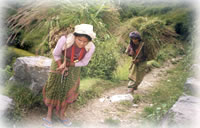 |
 |
||
 |
|||
|
RELATED THEMES employment and income migration OTHER LOCAL THEMES BACKGROUND |
livestock
Another factor leading to reduction of livestock mentioned by narrators is the splitting of joint families into nuclear ones - fewer people are available for livestock rearing. And at least one mentions a decrease in goats because children are now going to school instead of looking after them. Transhumant traders such as the Bhotiya also have fewer goats - the animals were a crucial part of the trek to Tibet and back, transporting their goods, but since India's conflict with China trade with Tibet has ceased. There is talk of the huts in the higher pastures where cattle are taken; the practice continues today. Several Gujjars, however, talk of how they have had to give up their migratory pastoralist lifestyle for one of settled farming, because the number of livestock the forests could support had become unsustainable. There have been some experiments with cross-breeding but none of the narrators is enthusiastic - success seems limited. Accompanying the loss of livestock is a reduction in animal power (for ploughing) and products, including dung and urine to fertilise and improve soil quality, and to use as pesticides. A couple of narrators talk about wool - their caste's traditional activities centred around spinning and weaving. Several women talk of significant reductions in milk and dairy products - one says she sells much less today but another says selling ghee etc still provides an income for some, mainly widows (India 28). Some say no one used to sell milk products before: families consumed most or all they had; any surplus was given to those neighbours without cows or buffaloes. And India 1 points out that cows perform important functions in religious ceremonies - people have to borrow them from the few who have them because so many families no longer have their own. quotes about livestock"Earlier people had lots of animals, sometimes 40 or 50. Everybody had at least 10 buffaloes. Now the number has come down to two, or at most, five. The numbers are decreasing day by day. Only those who are still nomads keep going up and down. We do not. We can't make a living if we go up to the forests, since we have only one or two animals. Here we can do some farming or even some labour jobs and make both ends meet. That's why we have settled down in the hills." "We used to have goats before but not now because all the children are working [or in school] these days so there is no one to look after the goats. We used to have our own wool but it was too little. So we generally bought wool from Tibetan people. Goats provided a good means for carrying goods to high altitudes." "There were so many problems [when we migrated up and down]. We had to walk with our animals the whole day. There were highway robberies. If an animal entered someone's field and Rs1000 was demanded in place of 10, we had to pay it. I narrate an incident to you - once while travelling one of my buffaloes ate something from a field. It was a ginger field and the plant had eleven stems out of which the buffalo
had eaten only three, but I had to pay a fine of Rs 300. "The rich used to slaughter 12 to 13 goats and the poor five to six and stock them up for winters. The horns were hung outside and the mincemeat was hung inside the room. It was consumed in winter. The goats used to have layers of fat. This was a result of the rich fodder available in those days.But, as human food has changed, animal fodder, too, has changed. Earlier both men and animals were very strong. Nowadays both have become weak. Cows that gave 4 litres of milk now give only one though they are of the same breed. It's all due to the quality of grass." "Earlier when the livestock had diseases. many animals died. We had no treatment for these diseases. Now the government has provided doctors both for human beings and animals." |
|
 Livestock are mentioned quite often and are clearly still a part of many people's livelihoods, though most say they keep far fewer animals now due to the loss of grazing land to cultivated fields, and the loss of fodder because of deforestation. Several say the quality of grass and fodder has also deteriorated and so the remaining animals are less healthy and productive. People speak of still using traditional cures but also say government vetinerary services have helped for those diseases that herbal medicine could not cure.
Livestock are mentioned quite often and are clearly still a part of many people's livelihoods, though most say they keep far fewer animals now due to the loss of grazing land to cultivated fields, and the loss of fodder because of deforestation. Several say the quality of grass and fodder has also deteriorated and so the remaining animals are less healthy and productive. People speak of still using traditional cures but also say government vetinerary services have helped for those diseases that herbal medicine could not cure.